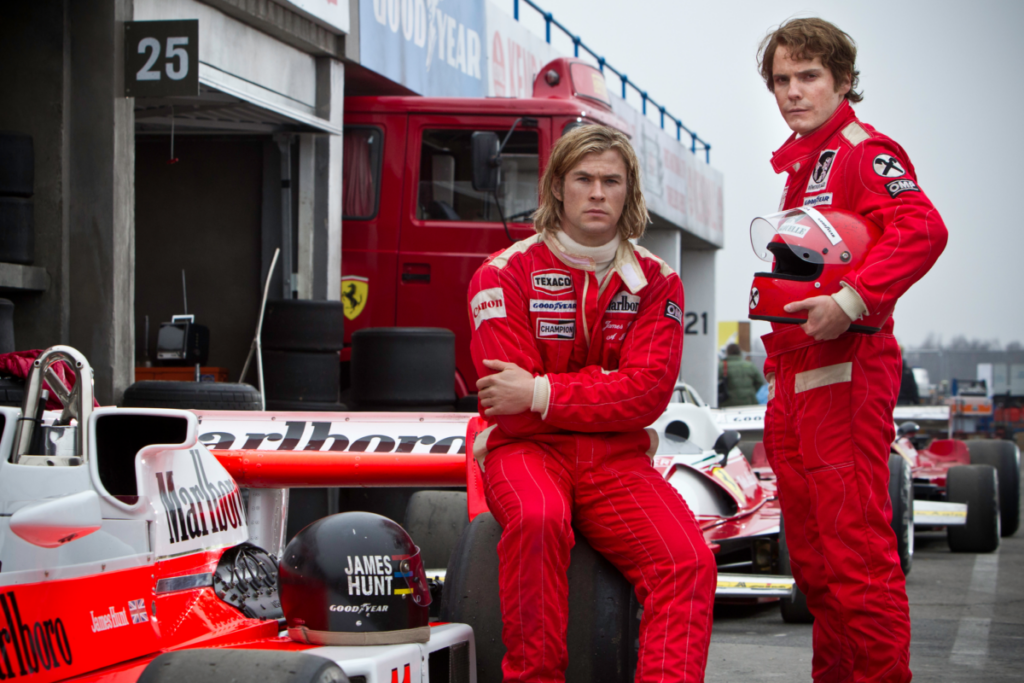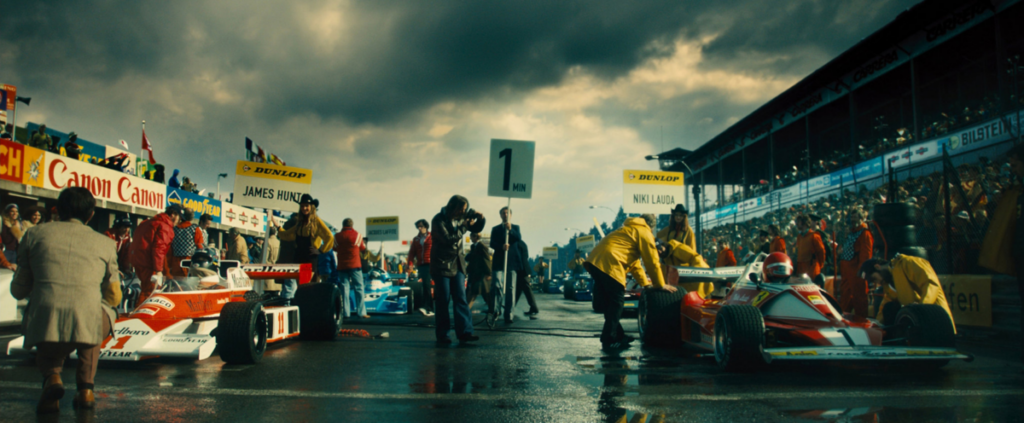
(Yes, that’s Thor, but he’s a race car driver here.)
Rush(2013) is a film based on the true story of a legendary rivalry between two drivers in the sport of Formula One, the British playboy James Hunt(Chris Hemsworth) and the Austrian and methodical Niki Lauda(Daniel Bruhl). The year in this film is set in 1976, so many things including the safety of these race cars are very different from what we see on Netflix’s Drive to Survive these days.
The film starts by introducing the two drivers. Hunt is charismatic, extremely confident in himself, and reckless. His recklessness is shown both on and off the racetrack. Lauda is on the more intelligent and calculating side, and prefers to be more precise than reckless. The plot is focused on their competition throughout the 1976 season. Lauda, who drives for Ferrari, dominates the early races of the year, with several victories. Hunt suffers personal problems such as marriage and financial hardships. What keeps him fighting for the win is nothing but his passion. Their rivalry reaches the peak when Lauda suffers a horrible crash that leaves him with 3rd degree burns all over his body. Though sustaining severe injuries, Lauda returns to the track just 6 weeks later. The two battle it out until the final race of 1976 in Japan, but the weather conditions are extremely bad. Lauda, still not fully recovered from his injury physically and emotionally, finds it hard to decide whether to keep racing in such conditions. Hunt, on the other hand, trusts his recklessness and pushes himself to the limit in one last attempt to win the season. In the end, Hunt finishes 3rd in the race, outscoring Lauda by just one point. The film concludes with the two acknowledging the respect they have for each other.

What I loved about this film is the cinematography. Both 50 years ago and now, Formula One was the peak of auto engineering technology. Teams had to build a car as aerodynamic and quick as possible to win races. However, these cars were not very safe, and electronic assistance was limited, which meant that drivers had to exert immense force on the steering wheel and brakes while blowing past at speeds up to more than 200 miles per hour. The camera work in this film captures this raw, nerve-wracking, and dangerous feeling perfectly. The movements are fast-paced, with POV shots in the car taking up a large amount of the shots. There is also a lot of handheld camera work, which makes the audience feel like they are in the cockpit, creating extreme tension. Moreover, the film often uses low angles to emphasize the speed of the cars and that the drivers are pushing to their limits. When the camera shows a driver, it shows him at extreme close-up shots to show emotions such as focus, fear, or determination.
The color palette also seems period-authentic, because the color grading is more toward warm tones such as brown, yellow, and orange. This gives off 70s film feelings and a vintage touch, like an archival footage. Colors are also utilized to show the contrasting life of Hunt and Lauda. For Hunt, bright colors and fast-moving visuals are used to give off a sense of excitement and the chaos that always surrounds him. For Lauda, his scenes feature more calm and controlled color tones, just like his focus on precision. This can be noticed especially in the scene where he is seen still recovering from the crash.
Also, last but not least, the historically accurate race cars and gear wholly satisfied me. As someone who has been watching Formula One for 9 years and has been into cars his whole life, I could not help but pay close attention to the small details. However, every detail I scrutinized was flawless. These details also help the audience immerse themselves in the film more deeply.
This is the clip of the final race where Hunt secured his championship.
https://www.youtube.com/watch?v=7q1LH1oExBM&ab_channel=KinoMan
Overall, if there is anyone who is currently searching for an adrenaline-packed “rush,” I would recommend this film. Even if the viewer knows nothing about auto racing, the close-to-raw camera movements and drama between the two drivers off track will be enough to captivate any type of audience.